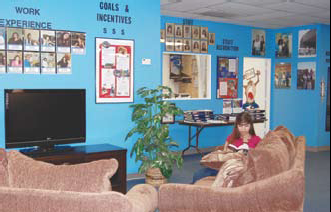Indio, Calif.—The federally funded Youth Opportunity Center (YOC) in this desert town is run by a muscular ex-ballplayer everyone calls Rock. He’s friendly as can be, but a visitor has to wonder if nonprofits that operate YOCs around the country should worry about the likes of him.
Charles “Rock” Nava oversees one of two YOCs in Riverside County that are operated by Arbor Education & Training – a company that is increasingly winning contracts around the country for youth employment and training services that have long been provided by nonprofits.
In fact, when Riverside County launched its YOCs nearly 10 years ago, three were run by a pair of nonprofits and two by a government agency. Now the latter two are run by Arbor, as part of a strategy that has helped the company expand over the past six years from five states to 23. Arbor now calls itself “the largest single supplier of job-related education, counseling and employment assis
 |
|
Dress for success: Mannequins show how to appear for job interviews. |
tance under federally funded programs.”
If anyone should worry about this, it would be Mary Jo Ramirez. She oversees the three other Riverside YOCs, which are run by the nonprofit California Family Life Center (CFLC). But so far, the nonprofit is holding its own and even conducts monthly meetings with the operators of the two centers run by Arbor.
Nel Taylor, spokeswoman for Arbor’s parent company ResCare, admits the arrival of a for-profit into nonprofit territory is often “looked on with suspicion.”
“You’re the new guy on the block, and people don’t understand how traditionally nonprofit services can be run by a for-profit,” Taylor says.
The county agency that awards the contracts finds little difference in service delivery. The nonprofit and for-profit each enjoys inherent advantages when it comes to funding and resources – to the point that neither seems to have a clear advantage.
Arbor’s Day
The Riverside County Economic Development Agency started its YOCs in 1999 with federal Workforce Investment Act funds. Over the years, the contracts have included CFLC (two centers), the Riverside YMCA and the Riverside Office of Education (two centers, including the one in Indio).
Services at all five one-stop centers are similar and include education and career strategies for each youth; referrals to community services; workforce training; job placement and retention; and tutoring, GED preparation and other academic help. The three-year contracts have ranged in recent years from $450,000 to $900,000 annually, says Felicia Flournoy, director of workforce development at the Economic Development Agency.
It turned out the Office of Education wasn’t the best fit for running the YOCs. When the contracts for its two centers in Indio and Perris came up for renewal starting in 2004, the bids were won by a for-profit: ACS Workforce Services, which had government contracts in California and 14 other states.
At about the same time, some big changes were taking place in the workforce training business.
 |
|
Nava: Former ballplayer, teacher turns youth agency manager. Photo: Patrick Boyle |
At the center of those changes was ResCare, the Louisville-based slugger of for-profit human services. ResCare runs residential and nonresidential programs for youth, working-age adults and seniors, including Job Corps centers, in 38 states. And ResCare, which buys other companies like some people buy shoes, was looking in the early 2000s to expand its youth employment and training services.
In 2003 it bought the employment and training division of Arbor Inc. – a job training and placement company, based in Media, Pa., and operating in five states, whose services included one-stop centers for youth.
Arbor Employment & Training became a subsidiary of ResCare. And that subsidiary later purchased two other workforce training providers: TTI America (which ran one-stop centers in two states) in 2004, and in 2006, ACS Workforce Services – the company that ran two of the YOCs in Riverside County.
Altogether, Arbor has grown to hold 120 contracts in 23 states, nearly 40 percent of which are specifically for youth services, Taylor says.
Differences
The Riverside County setup – with a nonprofit and a for-profit both operating YOCs – serves to illustrate several differences in what the two business models bring to youth programs.
When it comes to resources, the for-profit appears to have a big advantage. Last year, Arbor’s parent company, ResCare, reported a net income of $36.5 million, on $1.5 billion in total revenues, according to its most recent annual filing with the Securities and Exchange Commission (SEC). (ResCare would not provide specific income figures for Arbor.)
In contrast, CFLC is a regional operation, with annual revenue of $7.3 million, primarily on the YOCs in Riverside and foster care services in San Diego County.
And while the Riverside YMCA is affiliated with a large national nonprofit, its most recent federal tax returns shows income of $7.8 million in fiscal 2007, with expenses of $8.5 million.
The differences are not limited to money. Because Arbor runs similar types of programs around the country, it has developed common sets of materials that all of them can use. At the Economic Development Agency, Flournoy notes that the centers run by Arbor “have access to additional resources, which may have been developed and tested in different regions of the country. As needs arise, they are able to tap into these resources.”
Consider what this means for program managers like Nava – a 39-year-old former teacher, college baseball player (catcher) and coach, and wine marketer and salesman (this is California). Nava joined the Indio site as a case manager in 2004, and became program director soon after Arbor bought ACS.
After that purchase, Nava began attending training sessions elsewhere in California and in Las Vegas.
In addition, Arbor provides loads of support materials, covering just about anything an agency manager needs, such as personnel management, budgeting, payroll and community relations. If Nava needs marketing pamphlets, Arbor sends them. If Nava has a question about how to handle an issue in the office, he reaches up to the binders on his shelves, calls his regional director at Arbor, or raises it at one of the training conferences that Arbor runs several times a year.
And when it comes time to bid on contracts – all five Riverside YOCs were up for renewal in 2007 – Arbor has materials to help; Nava did not have to write a bid from scratch. “We have a central place to help people [site directors] with their RFPs [requests for proposals],” Taylor says. “We can’t expect him to have expertise in writing RFPs.”
At CFLC, Program Director Ramirez – a social work graduate with more than 20 years in the employment education and training field – writes the bids for the RFPs. Staff training, she says, is provided “through a variety of options,” most often carried out by contractors, and sometimes through other local nonprofits. Sometimes a foundation grant covers training, she says.
On the other hand, ResCare claims there are disadvantages when it comes to competing against local outfits for contracts. “Nonprofit providers may be affiliated with advocacy groups, health organizations, or religious organizations that have substantial influence with legislators and government agencies,” ResCare says in its SEC filings.
As for carrying out programs, nonprofits typically have some advantages. “Nonprofits are very good at establishing community partnerships,” says Flournoy. The partnerships are a key part of running a YOC – helping to recruit participants, hook them up with educational services and place them in jobs.
But nonprofits seem more likely than for-profits to struggle with some of the financial and human services requirements of a government contract, especially one in which payments depend on meeting various benchmarks. “In the past, we’ve had some nonprofit organizations that lacked the operational and fiscal capacity to operate a federally funded program,” Flournoy says.
That’s not true of California Family Life, she says. But something didn’t work right with the YMCA; it got out of its contract. (The YMCA did not respond to requests to discuss the issue.) The contract was taken over this year by CFLC, which had the next-highest scoring bid in the last competition to run that site.
Another advantage for nonprofits, cited by ResCare in its SEC documents: They can tap “government subsidies, foundation grants, tax-deductible contributions and other financial resources not available to us.”
Ramirez agrees, saying, “Because we are a nonprofit, we have different avenues for funding.”
CFLC supplements its government contract with foundation grants that pay for additional services at the YOCs. For example, the James Irvine Foundation provided a grant to help guide dropouts to postsecondary education. The state provided a grant for one center to help pregnant teens.
Ramirez expresses no concern about competition with Arbor, and administrators from the five Riverside YOCs meet once a month to discuss various issues with their centers.
Contracts are up for bid again next year. Asked about a possible expansion of Arbor to the other Riverside centers, Nava says, “That would be great, if Arbor ran all five YOCs.” He says this not in a predatory way, but in the matter-of-fact tone of a businessman who favors growth.
Flournoy, however, says her agency believes the mix of for-profit and nonprofit providers is working well.
Contact: Indio Win Center (760) 775-2887; CFLC (951) 765-6955, http://www.cflckids.org; Arbor Education and Training (512) 344-4000, http://www.arboret.com.





























